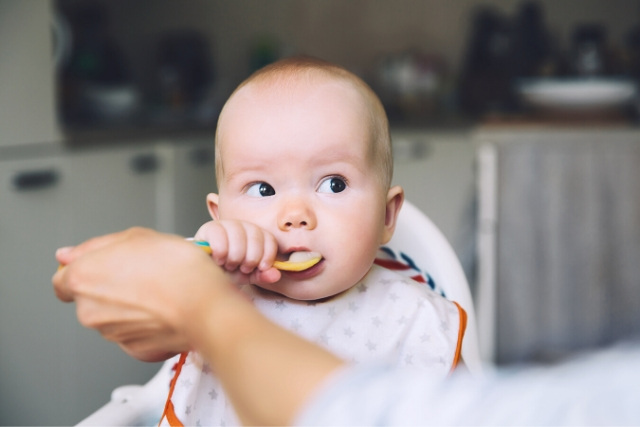Parents typically introduce solid foods when the baby is six months old. This time is called the weaning period, as you are transitioning from one type of food to another. Remember, you will still be feeding your baby breast or formula milk while gradually increasing the amount of solids they eat.
You will want to wait till around six months because breast milk or infant formula is what provides your baby with the energy and nutrients they need. Such milk, especially breast milk, will help protect your baby against infections and illness – you do not want to deprive your child from these important nutrients.
It will take time for your baby to go from milk to cope with solid foods. If your baby was born prematurely, then speak with your doctor before starting the weaning process.
Is my baby ready to eat solid food?
Look for the following signs:
- Your baby can stay sat in a sitting position and hold their head
- Swallow their food (and not spit it back out)
- Co-ordinate with their hands, eyes, and mouth
Once your baby can do the above, you can choose the type of weaning process. Baby led weaning (BLW) is when you let your baby feed itself. However, there is no set way to weaning your baby.
How do I start the process?
It is important to understand that your baby will not eat/need a lot of solid food when you first start the weaning process. This is because they will still need to drink their usual milk. You should also not worry about how much food they eat, rather it is more important for the baby to learn about new tastes and textures. Remember, your baby is still getting their nutrients from the milk.
Invest in the proper weaning equipment
Be sure to get all the essentials ready for the weaning process. This should include a high chair, baby-friendly cups, plates and cutlery, and a Bibado weaning bib to stop accidents from ruining your baby’s clothes.
Know what foods to avoid
-
Salt
Do not add stock cubes or gravy to any food you are planning on giving to your baby, as these food types are high in salt. Too much salt is not good for their kidneys, which is why you should never add salt to your baby’s food or even cooking water.
Other salty foods to avoid include:
- Bacon
- Crackers
- Crips
- Ready meals
- Sausages
-
Sugar
No baby needs to ingest sugar. Avoid sugary drinks and snacks such as fruit juice. By doing so, you will prevent tooth decay. You should also avoid other high-sugar foods like biscuits and cakes.
-
Honey
Honey may contain a bacterium that produces toxins in the baby’s intestines. This can lead to botulism – a very serious illness that attacks the nervous system and can lead to paralysis. You can give your child honey once they are over one year old.
-
Peanuts and whole nuts
Whole nuts and peanuts should not be given to children under 5 years old because they are a choking hazard. Rather, you should crush the nuts into a paste or peanut butter. Families with a history of nut allergies should avoid giving their baby nuts until they have spoken to their doctors.
-
Rice milks
Rice milks may contain too much arsenic, which is why no child under the age of 5 should use this milk type as a substitute to formula or breast milk.
-
Certain cheeses
While cheese can be part of a balanced and healthy diet (providing protein, vitamins, and calcium), babies should not ingest mold-ripened soft cheeses like brie or ripened goats’ milk cheese. Such cheeses have a higher risk of carrying the bacteria listeria.
Cheeses babies can eat, though, are pasteurized full-fat cheese like hard cheeses.
Get your baby off to a good start
Eating is a whole new skill, so you want your baby to accept new foods and textures as quickly as possible. This will take a lot of encouragement and praise; you will also need to be patient.
- Allow plenty of eating time
- Do not give up and keep trying with certain foods
- Go at your baby’s pace – do not force them to eat if they do not want to
- Patience is key; there will be days when they eat foods but won’t touch the same food the next day
- Your baby may enjoy touching foods – let them do this, as it could lead to them feeding themselves
- Do not distract your baby – this means no TV, tablets or phones should be present
- Show them how to eat
Be vigilant with hygiene and safety precautions
Always wash your hands before touching your baby’s food, and when preparing, make sure the surface is clean. Your food should not be offered as it might be too hot for them, so be sure to cool hot food and test it before.
Eliminate any choking hazards by cutting small, round foods such as cherry tomatoes into smaller, bite-sized pieces. You should also remove pips and stones from fruits and wash fruits and vegetables, too.
Textures
It can take a while to introduce new textures to your baby, but it is important to progress from blended and purified foods to ones that have lumpier textures. Your baby may reject the change in texture, which is why you need to make the transition slowly.
Keep offering your baby lumpier textures, and they will get used to it.
